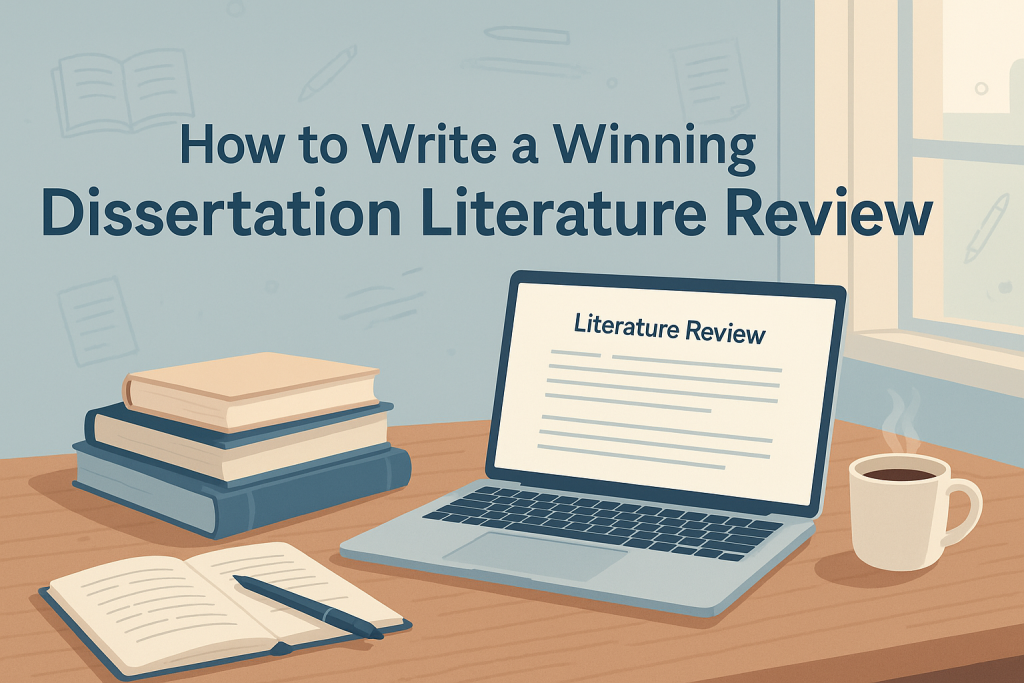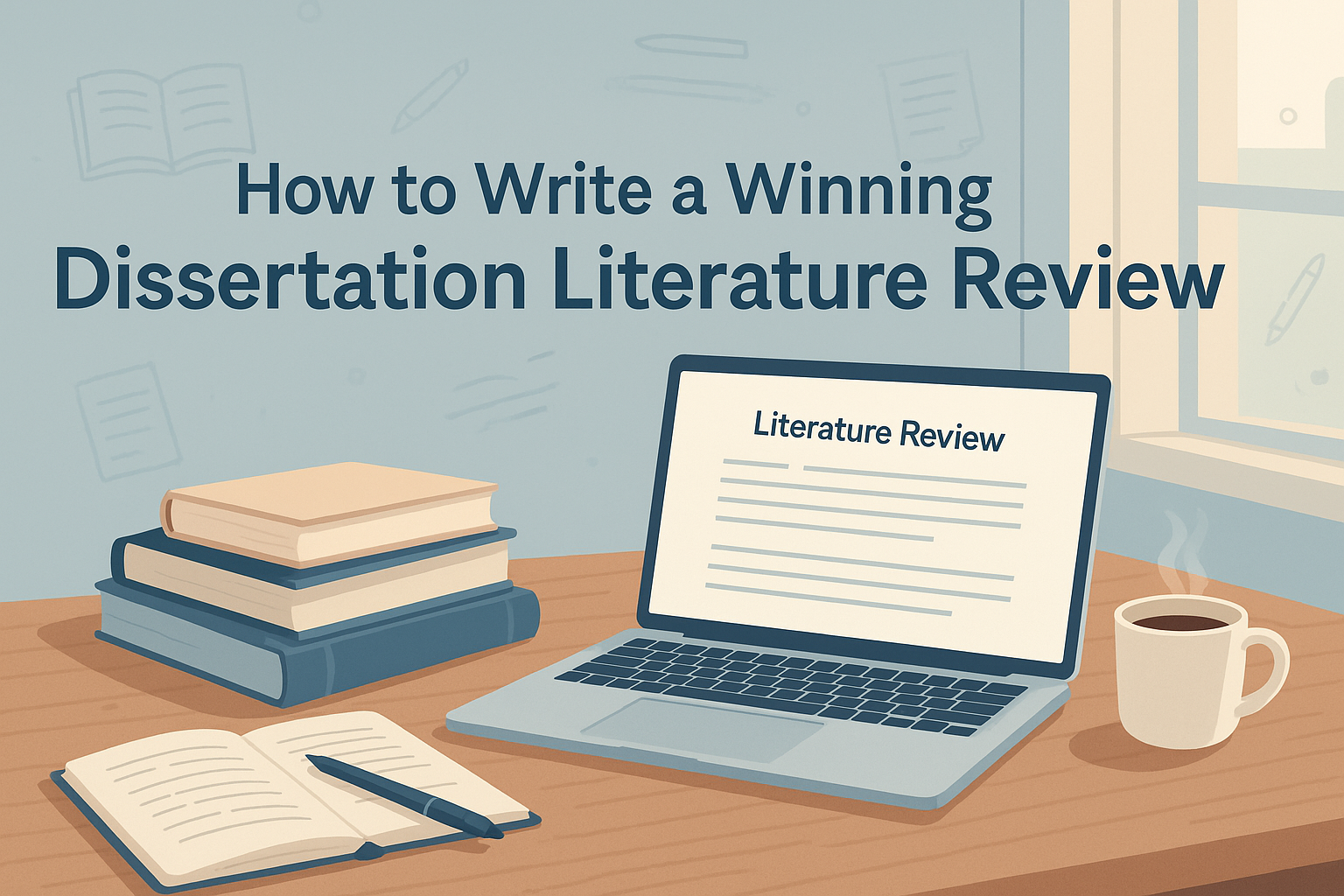Writing a dissertation literature review can be a daunting task, but it’s a crucial component of your academic journey. It’s not just about summarizing existing research; it’s about demonstrating your understanding of the subject matter and identifying gaps that your research can fill.
Imagine being able to confidently navigate the vast amount of existing research, synthesizing it into a coherent narrative that supports your research objectives. This is what a well-crafted literature review can achieve.

A well-structured literature review is key to a successful dissertation. It showcases your ability to critically analyze and synthesize existing knowledge, setting the stage for your original contribution.
Key Takeaways
- Understand the purpose of a literature review in your dissertation.
- Learn how to effectively search and select relevant literature.
- Discover tips for organizing and structuring your literature review.
- Gain insights into writing a clear and concise literature review.
- Find out how to critically analyze and synthesize existing research.
What Is a Dissertation Literature Review?
In the realm of academic writing, a dissertation literature review stands out as a pivotal element that contextualizes original research. It involves a comprehensive analysis and synthesis of existing research on a particular topic, providing a foundation for the dissertation.
Definition and Core Purpose
A literature review is defined as a critical evaluation of existing research on a specific topic. Its core purpose is to identify the current state of knowledge, highlighting gaps that the dissertation aims to address.
Types of Literature Reviews in Academic Research
Literature reviews can be categorized into several types, including:
- Narrative Reviews: Provide an overview of the current state of research on a topic.
- Systematic Reviews: Use a systematic method to identify, evaluate, and synthesize all relevant studies on a research question.
- Meta-analyses: Statistically analyze data from multiple studies to draw more general conclusions.
Understanding these types is crucial for academic literature review tips, as it helps in choosing the most appropriate approach for the research at hand.

The Importance of a Well-Crafted Literature Review
A well-crafted literature review is the backbone of any successful dissertation. It not only demonstrates your understanding of the research topic but also showcases your ability to critically analyze and synthesize existing research.
Establishing Your Academic Authority
A comprehensive literature review establishes your academic authority on the research topic. By engaging with existing literature, you demonstrate your grasp of the subject matter and your ability to contribute meaningfully to the academic discourse.
Identifying Research Gaps
A well-crafted literature review helps in identifying research gaps that your study can address. This not only justifies the relevance of your research but also guides your methodology and analysis.

Providing Theoretical Framework
The literature review provides a theoretical framework that underpins your research. It contextualizes your study within the broader academic landscape, making it easier to understand and interpret your findings.
Meeting UK Academic Standards
Moreover, a literature review that adheres to UK academic standards ensures that your dissertation meets the expectations of your examiners. It reflects your ability to engage with academic rigor and adhere to the conventions of academic writing in the UK.
By focusing on these aspects, you can create a literature review that not only supports your research but also enhances its overall credibility and impact.
Planning Your Dissertation Literature Review
Planning your dissertation literature review is a critical step that sets the stage for your entire research project. Effective planning ensures that your literature review is comprehensive, well-structured, and aligned with your research objectives.
Setting Clear Research Questions
To begin, it’s essential to set clear research questions that guide your literature search. These questions should be specific, measurable, and relevant to your research topic. By doing so, you’ll be able to focus your literature search and ensure that the sources you gather are pertinent to your study.
Creating a Realistic Timeline
Another crucial aspect is creating a realistic timeline for your literature review. This involves breaking down the task into manageable chunks, such as literature search, reading, note-taking, and writing. A well-planned timeline helps you stay on track and avoid last-minute rushes.
Organizing Your Research Materials
Organizing your research materials is also vital. This can be achieved through the use of reference management software and effective note-taking systems.
Reference Management Software Options
Reference management software, such as EndNote, Mendeley, or Zotero, helps you organize your sources, format citations, and generate bibliographies. The following table compares some popular reference management tools:
| Software | Key Features | Cost |
|---|---|---|
| EndNote | Citation management, PDF organization | Paid |
| Mendeley | Reference management, Collaboration tools | Free/Paid |
| Zotero | Source organization, Citation styles | Free |
Note-taking Systems
Effective note-taking systems enable you to capture key insights from your sources and synthesize the information. Techniques such as the Cornell Note-taking System or mind mapping can be particularly useful.
By carefully planning your dissertation literature review, you’ll be well-prepared to produce a high-quality piece of work that showcases your academic authority and contributes meaningfully to your field of study.
Effective Literature Search Strategies
The success of your dissertation literature review hinges on your ability to employ effective literature search strategies. A well-planned search strategy enables you to identify relevant databases, develop precise search terms, and document your findings systematically.
Identifying Relevant Databases and Sources
To start, it’s crucial to identify the most relevant databases and sources for your research topic. This involves:
- Exploring academic databases specific to your field of study
- Utilizing open access resources to broaden your search
Subject-Specific Databases
Different disciplines have their own set of databases. For instance, researchers in the field of medicine often rely on PubMed, while those in social sciences might use databases like JSTOR or Scopus. Identifying the key databases in your field is a critical step in conducting a thorough literature search.
Open Access Resources
In addition to subject-specific databases, open access resources such as DOAJ (Directory of Open Access Journals) and arXiv can provide valuable information. These resources offer a wealth of information that can be accessed freely, enhancing the breadth of your literature review.
Developing Search Terms and Boolean Operators
Crafting the right search terms is an art that involves using Boolean operators to refine your search results. By combining keywords with operators such as AND, OR, and NOT, you can narrow down or broaden your search to capture the most relevant literature.
For example, using the Boolean operator “AND” between two keywords will retrieve results that contain both terms, while using “OR” will retrieve results that contain either term. This technique helps in optimizing your search results.
Systematic Documentation Methods
Once you’ve identified and accessed relevant literature, it’s essential to document your findings systematically. This involves:
- Organizing your sources using reference management tools like Zotero or Mendeley
- Creating a database or spreadsheet to track your search results and notes
Systematic documentation ensures that you can easily retrieve and review the literature you’ve found, making the writing process more efficient.
Evaluating and Selecting Sources
A well-crafted literature review hinges on the ability to effectively evaluate and select relevant sources. This process involves a critical assessment of existing research to determine its credibility, relevance, and contribution to your research questions.
Assessing Source Credibility and Relevance
When evaluating sources, it’s essential to consider their credibility and relevance to your research topic. Credibility refers to the trustworthiness of the source, often determined by the author’s expertise, the publication’s reputation, and the methodology used. Relevance pertains to how closely the source aligns with your research questions and objectives.
To assess credibility, consider the following factors:
- Author credentials and expertise
- Publication date and currency of information
- Peer-review status
- Methodological transparency and rigor
Balancing Seminal Works and Current Research
A balanced literature review includes both seminal works that have significantly influenced the field and current research that reflects the latest developments. Seminal works provide foundational knowledge, while current research highlights recent advancements and debates.
“The literature review is not merely a summary of existing research; it is a synthesis that demonstrates your understanding of the research topic and its evolution over time.”
Recognizing Methodological Strengths and Weaknesses
Understanding the methodological strengths and weaknesses of the studies you review is crucial. This involves evaluating the research design, data collection methods, and analysis techniques used in each study.
Quantitative Research Evaluation
When evaluating quantitative research, consider the sample size, data collection methods, and statistical analysis used. A robust quantitative study should have a sufficiently large sample size and appropriate statistical methods.
Qualitative Research Evaluation
For qualitative research, assess the data collection methods, such as interviews or observations, and the analytical techniques used. Qualitative studies should provide rich, contextual insights into the research topic.
| Research Type | Key Evaluation Criteria |
|---|---|
| Quantitative Research | Sample size, data collection methods, statistical analysis |
| Qualitative Research | Data collection methods, analytical techniques, contextual insights |
Structuring Your Dissertation Literature Review
The structure of a dissertation literature review is pivotal in presenting a coherent narrative that guides the reader through the research landscape.
A well-structured literature review can be achieved through various organizational methods. Chronological Organization is one such approach, where studies are reviewed in the order they were published. This method is particularly useful for tracing the development of research over time.
Chronological Organization
Chronological organization helps in identifying how research has evolved, highlighting key milestones and shifts in the field. However, it may not be suitable for all topics, especially where the timeline of publications does not directly correlate with the significance or relevance of the research.
Thematic Organization
Thematic Organization involves grouping studies based on themes or subtopics related to the research question. This approach allows for a more nuanced discussion of the literature, comparing and contrasting findings across different studies within each theme.
Methodological Organization
Methodological Organization categorizes studies based on their research methodologies. This structure is beneficial for evaluating the strengths and weaknesses of different methodological approaches and their impact on research outcomes.
Creating a Logical Flow Between Sections
Regardless of the chosen organizational structure, creating a logical flow between sections is crucial. Transitional phrases and clear headings can help guide the reader through the literature review, ensuring that the narrative remains coherent and engaging.
To achieve a logical flow, it’s essential to use transitional phrases that connect ideas between paragraphs and sections. Additionally, clear and concise headings can significantly enhance the readability of the literature review.
Here are some key strategies for creating a logical flow:
- Use transitional phrases to connect ideas between paragraphs.
- Employ clear and concise headings to guide the reader.
- Ensure that each section logically follows from the previous one.
Critical Analysis Techniques for Literature Reviews
A literature review is more than just a summary of existing research; it requires a critical analysis to synthesize the findings effectively. This section delves into the techniques that enable you to critically analyze literature, thereby strengthening your dissertation.
Moving Beyond Summary to Synthesis
To move beyond summary, you must synthesize the information. Synthesis involves combining the findings of various studies to draw broader conclusions. It’s about understanding the relationships between different pieces of research and identifying how they contribute to the overall understanding of your research topic.
Identifying Patterns, Trends, and Contradictions
When reviewing literature, it’s crucial to identify patterns, trends, and contradictions. Patterns may emerge in the methodologies used or the populations studied, while trends can indicate the direction in which the field is moving. Contradictions, on the other hand, highlight areas of debate that require further investigation.
| Technique | Description | Benefit |
|---|---|---|
| Synthesis | Combining findings to draw broader conclusions | Provides a comprehensive understanding |
| Pattern Identification | Recognizing recurring themes or methodologies | Helps in understanding research trends |
| Critical Perspective | Analyzing studies with a discerning eye | Enhances the validity of your research |
Developing Your Academic Voice
Developing your academic voice is vital in a literature review. This involves not just summarizing what others have said, but also critiquing and analyzing their work. Your academic voice is established through your ability to engage critically with the literature.
Balancing Description and Analysis
A key aspect of critical analysis is balancing description and analysis. While some description is necessary to contextualize the research, the focus should be on analysis that reveals your understanding and interpretation of the literature.
Incorporating Critical Perspective
Incorporating a critical perspective involves evaluating the strengths and weaknesses of the studies you’re reviewing. It’s about questioning the methodologies, sample sizes, and conclusions drawn by other researchers.
By mastering these critical analysis techniques, you’ll be able to craft a literature review that not only summarizes existing research but also contributes meaningfully to the academic discourse in your field.
Writing the Dissertation Literature Review
The literature review is a cornerstone of dissertation writing, requiring meticulous planning and execution. It serves as the foundation upon which your research is built, providing a comprehensive overview of existing knowledge on your topic.
Crafting an Engaging Introduction
Your literature review should begin with an engaging introduction that sets the stage for the discussion to follow. This introduction should provide context for your research, outline the scope of the review, and clearly state the research questions or hypotheses being investigated. An effective introduction will capture the reader’s attention and provide a roadmap for the rest of the literature review.
Developing the Main Body with Clear Transitions
The main body of your literature review should be organized in a logical and coherent manner, using clear transitions to guide the reader through your argument. This can be achieved through various organizational structures, such as chronological, thematic, or methodological approaches. Regardless of the structure chosen, it is crucial to ensure that the discussion flows smoothly and that the reader can follow your line of reasoning.
Writing a Compelling Conclusion
A compelling conclusion is essential for summarizing the key findings of your literature review and highlighting the research gaps that your dissertation aims to address. This section should synthesize the main points discussed, reiterate the significance of your research, and provide a clear link to your research questions.
Summarizing Key Findings
In summarizing the key findings, you should distill the main contributions of the literature review into concise statements, highlighting the most critical insights and discoveries.
Highlighting Research Gaps
Identifying and highlighting research gaps is crucial for justifying your dissertation’s contribution to the field. This involves critically evaluating the existing literature to pinpoint areas where further research is needed.
Connecting to Your Research Questions
Finally, it is essential to connect the literature review to your research questions, demonstrating how the review informs your investigation and shapes your research methodology. This connection is vital for establishing the relevance and significance of your dissertation.
By following these guidelines, you can produce a well-structured and effective literature review that enhances the overall quality of your dissertation.
Common Pitfalls in Dissertation Literature Reviews
Crafting a compelling dissertation literature review requires avoiding several common mistakes that can undermine your research. A literature review is not just a summary of existing research; it’s a critical analysis that sets the foundation for your study.
Descriptive Rather Than Analytical Writing
One of the most significant pitfalls is falling into descriptive writing instead of analytical writing. A descriptive literature review merely summarizes sources, whereas an analytical review evaluates, synthesizes, and contextualizes the literature.
Poor Organization and Structure
Poor organization can make your literature review difficult to follow. A clear structure, whether chronological, thematic, or methodological, is essential for coherence.
| Common Pitfalls | Description | Solution |
|---|---|---|
| Descriptive Writing | Summarizes sources without analysis | Critically evaluate and synthesize literature |
| Poor Organization | Lack of clear structure | Use a logical structure (chronological, thematic, methodological) |
| Inadequate Critical Engagement | Failure to critically assess literature | Engage deeply with the literature, identifying gaps and debates |
Inadequate Critical Engagement
Inadequate critical engagement with the literature can weaken your review. It’s crucial to critically assess the methodologies, findings, and limitations of existing research.
Failing to Connect to Research Questions
Finally, failing to connect your literature review to your research questions can make it seem irrelevant. Ensure that your review is aligned with your research objectives.
Refining Your Literature Review
Refining your literature review involves several key steps that can significantly enhance its quality and impact. This process is crucial for producing a dissertation that meets academic standards.
Self-Revision Strategies
Begin by revising your literature review yourself. Check for clarity, coherence, and flow. Ensure that your arguments are well-supported and that the review is well-organized.
Seeking Supervisor and Peer Feedback
After self-revision, seek feedback from your supervisor and peers. Their insights can help identify areas for improvement and provide new perspectives on your work.
Final Editing and Proofreading Techniques
During the final stages, focus on editing and proofreading. Check for grammatical errors, consistency in formatting, and accuracy in citations.
Language and Style Considerations
Pay attention to the language and style used in your literature review. Ensure it is formal, clear, and consistent with academic standards.
Citation and Formatting Checks
Verify that your citations and references are correctly formatted according to your institution’s guidelines. This attention to detail is crucial for maintaining academic integrity.
Exemplary Dissertation Literature Review Examples
To understand what makes a literature review outstanding, it’s essential to analyze exemplary dissertation literature review examples from various disciplines. By doing so, students can gain insights into the structure, analysis, and synthesis that characterize a well-crafted literature review.
Case Studies from Various Disciplines
Examining literature reviews from different fields such as sociology, psychology, and environmental science can illustrate the diverse approaches to synthesizing research. For instance, a literature review in sociology might focus on thematic analysis, while one in environmental science could emphasize methodological comparisons.
Analysis of Effective Elements
Effective literature reviews share certain characteristics, including a clear research question, comprehensive coverage of relevant literature, and critical analysis. The following table highlights key elements found in exemplary literature reviews:
| Element | Description | Example |
|---|---|---|
| Clear Research Question | Guides the focus of the literature review | “How does climate change affect biodiversity?” |
| Comprehensive Coverage | Includes seminal works and recent research | Incorporating both classic theories and current studies on climate change. |
| Critical Analysis | Evaluates the strengths and limitations of existing research | Discussing the methodological strengths of recent climate change studies. |
Applying Best Practices to Your Own Work
By analyzing exemplary dissertation literature reviews, students can apply best practices to their own work. This involves setting clear research questions, organizing the literature thematically or methodologically, and critically engaging with the existing research.
To excel in writing a literature review, it’s crucial to balance summary with synthesis, ensuring that your work contributes meaningfully to the academic discourse.
Conclusion: Mastering the Art of Literature Review Writing
Mastering the art of literature review writing is crucial for producing a high-quality dissertation. By understanding the core purpose and types of literature reviews, you can effectively establish your academic authority and identify research gaps.
A well-crafted dissertation literature review requires careful planning, effective literature search strategies, and critical analysis techniques. By applying these strategies and techniques, you can create a comprehensive and compelling literature review that meets UK academic standards.
To excel in literature review writing, it’s essential to develop your academic voice, balance seminal works and current research, and create a logical flow between sections. By doing so, you’ll be able to write a literature review that not only showcases your knowledge but also demonstrates your ability to think critically and analytically.
By following the guidelines outlined in this article, you’ll be well on your way to mastering the art of literature review writing and producing a dissertation that stands out. Effective literature review writing is a skill that can be developed with practice, patience, and persistence, enabling you to succeed in your academic pursuits.
Need professional assistance with your dissertation literature review? Get expert help from our team to ensure your work is comprehensive and well-crafted.
FAQ
What is the purpose of a literature review in a dissertation?
The purpose of a literature review in a dissertation is to provide an overview of the current state of knowledge on a particular topic, identify research gaps, and establish the significance of the research.
How do I structure my dissertation literature review?
You can structure your dissertation literature review chronologically, thematically, or methodologically, depending on the nature of your research and the requirements of your discipline.
What are the key elements of a well-crafted literature review?
A well-crafted literature review should demonstrate a clear understanding of the research topic, provide a comprehensive overview of the relevant literature, identify research gaps, and establish the significance of the research.
How do I evaluate sources for my literature review?
To evaluate sources for your literature review, you should assess their credibility, relevance, and methodological strengths and weaknesses, and consider the balance between seminal works and current research.
What are some common pitfalls to avoid in a dissertation literature review?
Common pitfalls to avoid in a dissertation literature review include descriptive rather than analytical writing, poor organization and structure, inadequate critical engagement, and failing to connect to research questions.
How can I refine my literature review?
You can refine your literature review by using self-revision strategies, seeking feedback from supervisors and peers, and employing final editing and proofreading techniques, including language and style considerations, and citation and formatting checks.
What is the importance of a literature review in academic research?
A literature review is essential in academic research as it provides a foundation for the research, establishes the researcher’s authority, and helps to identify research gaps and areas for further investigation.
How do I conduct a literature search for my dissertation?
To conduct a literature search for your dissertation, you should identify relevant databases and sources, develop effective search terms using Boolean operators, and document your findings systematically.
What are the different types of literature reviews used in academic research?
The different types of literature reviews used in academic research include narrative reviews, systematic reviews, and meta-analyses, each with its own strengths and limitations.
How do I balance description and analysis in my literature review?
To balance description and analysis in your literature review, you should aim to provide a clear and concise summary of the relevant literature while also critically evaluating the sources and identifying patterns, trends, and contradictions.







